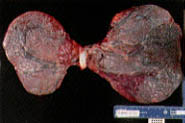Bilobed and Trilobed Placentas
Frequently Asked Questions
To be classified as bipartite or tripartite the two or three lobes of a placenta should be separated by a membrane and be of
equal or near equal size. There is no certain information on how multilobed placentas are formed. A bipartite placenta in one
pregnancy may be followed by greater-than-expected frequency of bipartite placenta in the next pregnancy. This raises the possibility
that some multilobed placentas have genetic origin. The umbilical cord most often inserts into the membranes between the two lobes of
bipartite placentas but in about one-third of cases it inserts into the larger of the two lobes.
The two clinical manifestations of multilobed placetas most often cited are bleeding in the first trimester of pregnancy,
and a failure of one of the lobes to separate at delivery with consequent postpartum hemorrhage. There are also published reports
that bilobed placentas increase in frequency with advanced maternal age and with a maternal history of infertility. Antecedent
risk factors include maternal cigarette smoking during pregnancy, mother being >34 yrs of age, excessive vomiting during the first
trimester of pregnancy, diabetes mellitus, and one of the parents or a sibling having a chronic seizure disorder. Taking all these
risk factors into consideration, multilobed placentas do not have any unfavorable short-term or long-term pregnancy outcomes.
Vasa previa results from a bilobed placenta when fetal vessels joining the two lobes of the placenta are located between the
baby's presenting part and the cervix or if the cord insertion is located between the two lobes (velamentous insertion of a
bilobed placenta).
